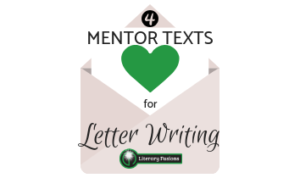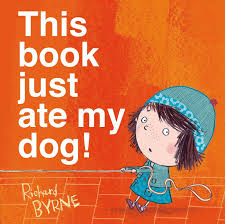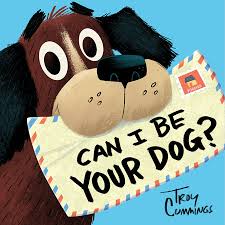 I love it when a book bag comes together! Every so often, my seemingly random selection of books from the library (the combined efforts of my 17-month-old who selects based on what she can reach, the 5-year-old who selects based on the color and the animal on the cover, and myself who tries to keep up with both of them) aligns to reveal an actual educational connection! Today, my kids’ obsession with dragons and dogs brings you a collection of books that feature letter-writing.
I love it when a book bag comes together! Every so often, my seemingly random selection of books from the library (the combined efforts of my 17-month-old who selects based on what she can reach, the 5-year-old who selects based on the color and the animal on the cover, and myself who tries to keep up with both of them) aligns to reveal an actual educational connection! Today, my kids’ obsession with dragons and dogs brings you a collection of books that feature letter-writing.
Students of all ages in elementary school are required to produce letters both formal and informal that include proper conventions such as a salutation, closing, etc. This skill is far from out-dated! The skill of letter-writing, being able to communicate effectively to a specific audience, to present ideas logically, and convey ideas clearly easily transfers into the digital realm of electronic communication as well!
While we all love Patricia Polacco’s Thank You, Mr. Falker, here are some more choices for mentor texts on letter writing!
 It Came in the Mail, by Ben Clanton. Kids love mail, and this book opens with Liam, who is no exception. However, Liam never gets any. He realizes that maybe, if he sent some mail, he’ll get some in return, and so he proceeds to write to his mailbox. The mailbox, of course, is magic, and so Liam is rewarded with all kinds of interesting mail. The mixed media illustrations feature all kinds of envelopes, postcards, postmarks, and stamps, and the characters and objects drawn by Clanton are whimsical and captivating. It Came in the Mail is an incredibly imaginative, captivating story that could lead any number of different writing assignments beyond just letter-writing: What would you ask the mailbox for? What would you do with the objects? What’s the most exciting thing you’ve ever gotten in the mail?
It Came in the Mail, by Ben Clanton. Kids love mail, and this book opens with Liam, who is no exception. However, Liam never gets any. He realizes that maybe, if he sent some mail, he’ll get some in return, and so he proceeds to write to his mailbox. The mailbox, of course, is magic, and so Liam is rewarded with all kinds of interesting mail. The mixed media illustrations feature all kinds of envelopes, postcards, postmarks, and stamps, and the characters and objects drawn by Clanton are whimsical and captivating. It Came in the Mail is an incredibly imaginative, captivating story that could lead any number of different writing assignments beyond just letter-writing: What would you ask the mailbox for? What would you do with the objects? What’s the most exciting thing you’ve ever gotten in the mail?
 This Book Just Ate My Dog, by Richard Byrne. This book is a read-aloud gem – short on text, huge on storyline and reader engagement! It begins with Bella taking her sweet dog for a walk. But the book EATS the dog as it attempts to cross to the other side of the two-page spread. Bella stands confused as the book continues to eat a host of other characters. Finally, Bella herself is consumed as she goes in to investigate. Then, out of the gutter, pops a letter, with instructions to the reader on how they can help rescue the characters! My preschool classes loved the story and interacting with the book, while my older elementary students could focus more on the story and the letters. Home run!
This Book Just Ate My Dog, by Richard Byrne. This book is a read-aloud gem – short on text, huge on storyline and reader engagement! It begins with Bella taking her sweet dog for a walk. But the book EATS the dog as it attempts to cross to the other side of the two-page spread. Bella stands confused as the book continues to eat a host of other characters. Finally, Bella herself is consumed as she goes in to investigate. Then, out of the gutter, pops a letter, with instructions to the reader on how they can help rescue the characters! My preschool classes loved the story and interacting with the book, while my older elementary students could focus more on the story and the letters. Home run!
 Can I Be Your Dog?, by Troy Cummings. I picked this one up because of the cover – the puppy dog eyes worked! Arfy is a lonely puppy who is looking for his forever home. His story is told in a series of letters back and forth between Arfy and his prospective owners. Each time Arfy sends a letter, we get to read it and see the house he sent it to, then on the next page, we see the response and Arfy’s reaction. So much going on here – inferencing, character development, setting, etc. Arfy goes through every house on Butternut street (there’s a nice map of sorts in the back – so you could tie in some relative location words too), and everyone declines his request. At last, Arfy actually gets a letter from a seemingly minor character who has been an integral part of the story but stays in the background until the very end. It’s fun to go back through and reread this one after you find out how it ends! Lots of different kinds of letters to look at here, and it could a good introduction to other epistolatory stories where the reader has to pull lots of information together to actually create a storyline.
Can I Be Your Dog?, by Troy Cummings. I picked this one up because of the cover – the puppy dog eyes worked! Arfy is a lonely puppy who is looking for his forever home. His story is told in a series of letters back and forth between Arfy and his prospective owners. Each time Arfy sends a letter, we get to read it and see the house he sent it to, then on the next page, we see the response and Arfy’s reaction. So much going on here – inferencing, character development, setting, etc. Arfy goes through every house on Butternut street (there’s a nice map of sorts in the back – so you could tie in some relative location words too), and everyone declines his request. At last, Arfy actually gets a letter from a seemingly minor character who has been an integral part of the story but stays in the background until the very end. It’s fun to go back through and reread this one after you find out how it ends! Lots of different kinds of letters to look at here, and it could a good introduction to other epistolatory stories where the reader has to pull lots of information together to actually create a storyline.
 Dear Dragon: A Pen Pal Tale, by Josh Funk. (Read the full post here!) Two very different classrooms are matched up as pen pals for the school year, and this book records the communication between Blaise Dragomir (dragon) and George Slair (human). Through letters written in rhyme, the two boys find that they actually do a lot of the same things in their daily lives, just in very different ways. Oblivious to the differences in their species, the pen pals develop a friendship and eventually get the chance to meet at the end of the year. The ending is a sweet reminder that differences don’t have to prevent friendships.
Dear Dragon: A Pen Pal Tale, by Josh Funk. (Read the full post here!) Two very different classrooms are matched up as pen pals for the school year, and this book records the communication between Blaise Dragomir (dragon) and George Slair (human). Through letters written in rhyme, the two boys find that they actually do a lot of the same things in their daily lives, just in very different ways. Oblivious to the differences in their species, the pen pals develop a friendship and eventually get the chance to meet at the end of the year. The ending is a sweet reminder that differences don’t have to prevent friendships.






Leave a Reply